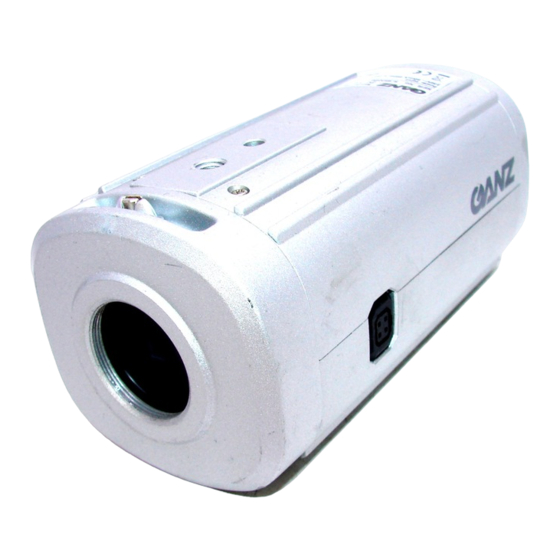Ganz ZC-Y41PH3 Manuale di istruzioni - Pagina 2
Sfoglia online o scarica il pdf Manuale di istruzioni per Telecamera di sicurezza Ganz ZC-Y41PH3. Ganz ZC-Y41PH3 2. Color ccd camera

CONNECTION AND ADJUSTMENT
Important Note:
Qualified service personnel or system installers should perform the installation.
Make sure that the power is OFF before handling the power supply cable.
Power Supply Cable Connection
→ refer to PARTS DESCRIPTON (12)
The camera operates with an AC mains power supply (230V).
Connect the power cable to the power input connector or terminal on the
rear panel.
The Power LED on the rear panel is lit when the camera is connected to a
power source (refer to Parts Description 11).
Video Cable Connection
→ refer to PARTS DESCRIPTON (8)
Connect the 75Ω coaxial cable to video output terminal.
Auto Iris Lens Connections
→ refer to PARTS DESCRIPTON (4) & (7)
This camera supports manual iris lens, video auto iris lens,
and DC auto iris lens.
1. Video Auto Iris Lens Pin assignment
GND: Shield, ground.
+12V: Power source; +12VDC, 50 mA Max.
Video: Video signal output.
2. DC Auto Iris Lens
The 4 pin connection terminal is on the
rear panel. Refer to the pin assignment
to ensure the proper operation.
Lens Mounting
→ refer to PARTS DESCRIPTON (1)
1. Mount a lens onto the camera lens mount. Turn the lens clockwise.
2. This camera can accept CS-mount lens, or C-mount lens with a 5 mm adaptor ring.
Cautions for lens mounting:
1. In case of using a lens heaver than the camera, the lens and camera will require
additional support.
2. Do not over-tighten the lens onto the camera mount.
3. Do not rotate the lens counter-clockwise.
Focus Adjustment
→ refer to PARTS DESCRIPTON (2) & (3)
1. Loosen the back focus adjustment lever located
on the front head.
2. Adjust the screw to a desired position, and then
fix the screws.
Caution for focus adjustment:
1. Do not over-tighten the back focus screw.
2. Do not attempt to use any tools other than fingers to tighten the screw.
Improper focus adjustment may result in severe damages to the back-focus
echanism or to the CCD image sensor.
DIP SWITCHES SETTING
→ Refer to PARTS DESCRIPTION (6)
The row of DIP switches allow the following settings to be made:
•LL / INT
The line-lock mode enables the AC line phase adjustment.
Note: The line-lock sync mode is not available when the camera
operates on DC power.
•SDN / ON
This feature enables the camera operates in monochrome mode in reduced lighting.
Switch to ON to activate.
•BLC / ON
The Backlight Compensation feature eliminates the effect of strong background
lighting, maintaining the correct exposure. Switch to ON to activate. When switched
to BLC, the feature is off.
•AGC / TURBO
The Automatic Gain Control feature can improve picture quality in low lighting
conditions.
Select TURBO for most applications. Setting to AGC will reduce 'noise' from the
image,
but it will also limit the camera's sensitivity.
•AES/ ON
Selecting ON enables Electronic Iris mode, which compensates for excessive light
levels by automatically adjusting the camera shutter speed. This mode should only
be used with fixed or manual iris lenses.
•F.L. / ON
When this switch is set to ON, the camera reduces flicker in the image under
fluorescent lighting.
POTENTIOMETER SETTING
→ Refer to PARTS DESCRIPTION (9) & (10)
•LEVEL (Auto Lens Control Level Adjustment)
This potentiometer controls DC lenses:
it manages CCD sensor light quantity by adjusting lens IRIS aperture.
•V-Phase (Line Lock Phase Adjustment)
When the camera is set to Line-Lock mode (LL), it is possible to adjust camera
triggering point on the AC cycle in case of systems using sequential switchers
devoid of image digital process feature or video matrixes.
See also 'DIP SWITCH SETTING' (LL/INT).
